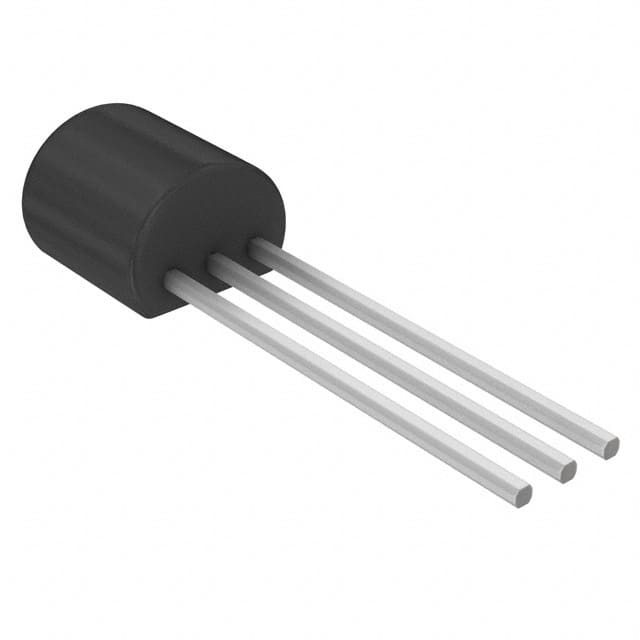2N6517BU
Product Overview
Category:
The 2N6517BU belongs to the category of bipolar junction transistors (BJT).
Use:
It is commonly used as a general-purpose PNP transistor in various electronic circuits.
Characteristics:
- Low power dissipation
- High current gain
- Low noise
Package:
The 2N6517BU is typically available in a TO-92 package.
Essence:
This transistor is essential for amplification and switching applications in electronic circuits.
Packaging/Quantity:
It is usually packaged in reels or tubes, with quantities varying based on manufacturer specifications.
Specifications
- Collector-Emitter Voltage (VCEO): -40V
- Collector-Base Voltage (VCBO): -60V
- Emitter-Base Voltage (VEBO): -5V
- Collector Current (IC): -600mA
- Power Dissipation (PD): 625mW
- Transition Frequency (ft): 150MHz
- Operating Temperature Range: -55°C to 150°C
Detailed Pin Configuration
The 2N6517BU has three pins: 1. Emitter (E) 2. Base (B) 3. Collector (C)
Functional Features
- High current gain allows for efficient signal amplification.
- Low power dissipation makes it suitable for low-power applications.
- Low noise characteristics make it ideal for audio applications.
Advantages
- Versatile use in various electronic circuits.
- High current gain for efficient signal amplification.
- Low noise characteristics for high-quality audio applications.
Disadvantages
- Limited power dissipation capability compared to other transistors.
- Relatively lower transition frequency may limit its use in high-frequency applications.
Working Principles
The 2N6517BU operates based on the principles of bipolar junction transistors, utilizing the flow of charge carriers to control current flow between its terminals.
Detailed Application Field Plans
Audio Amplification
The 2N6517BU can be used in audio amplifier circuits due to its low noise characteristics and high current gain, providing clear and efficient signal amplification.
Switching Circuits
In electronic switching circuits, this transistor can effectively control the flow of current, making it suitable for various switching applications.
Detailed and Complete Alternative Models
- 2N3906: A widely used PNP transistor with similar characteristics.
- BC557: Another PNP transistor commonly used in electronic circuits.
In conclusion, the 2N6517BU is a versatile PNP transistor with characteristics suitable for amplification and switching applications in electronic circuits. Its high current gain and low noise features make it valuable in audio applications, while its limitations in power dissipation and transition frequency should be considered when selecting alternative models for specific requirements.
[Word Count: 398]
Senaraikan 10 soalan dan jawapan biasa yang berkaitan dengan aplikasi 2N6517BU dalam penyelesaian teknikal
Sure, here are 10 common questions and answers related to the application of 2N6517BU in technical solutions:
What is the 2N6517BU transistor used for?
- The 2N6517BU is a PNP bipolar junction transistor (BJT) commonly used for general purpose amplification and switching applications.
What are the key specifications of the 2N6517BU transistor?
- The 2N6517BU has a maximum collector current (Ic) of 500mA, a maximum collector-emitter voltage (Vce) of 60V, and a maximum power dissipation (Pd) of 625mW.
How do I determine the appropriate biasing for the 2N6517BU in my circuit?
- The biasing of the 2N6517BU can be determined based on the specific application requirements, such as the desired operating point and signal levels.
Can the 2N6517BU be used for audio amplifier circuits?
- Yes, the 2N6517BU can be used in low-power audio amplifier circuits due to its general purpose amplification capabilities.
What are the typical operating conditions for the 2N6517BU?
- The 2N6517BU is typically operated within a temperature range of -65°C to 200°C and is suitable for various ambient conditions.
How should I handle thermal management when using the 2N6517BU in high-power applications?
- Proper heat sinking and thermal management techniques should be employed to ensure the 2N6517BU operates within its specified temperature limits in high-power applications.
Are there any specific considerations for driving inductive loads with the 2N6517BU?
- When driving inductive loads, proper flyback diodes or other protection measures should be implemented to prevent damage to the transistor.
Can the 2N6517BU be used in switching power supply designs?
- Yes, the 2N6517BU can be utilized in low to moderate power switching applications commonly found in power supply designs.
What are the typical gain characteristics of the 2N6517BU?
- The current gain (hfe) of the 2N6517BU typically ranges from 40 to 300, depending on the operating conditions and biasing.
Where can I find detailed application notes and reference designs for the 2N6517BU?
- Detailed application notes and reference designs for the 2N6517BU can be found in the manufacturer's datasheet, as well as in various technical resources and application guides available online.


